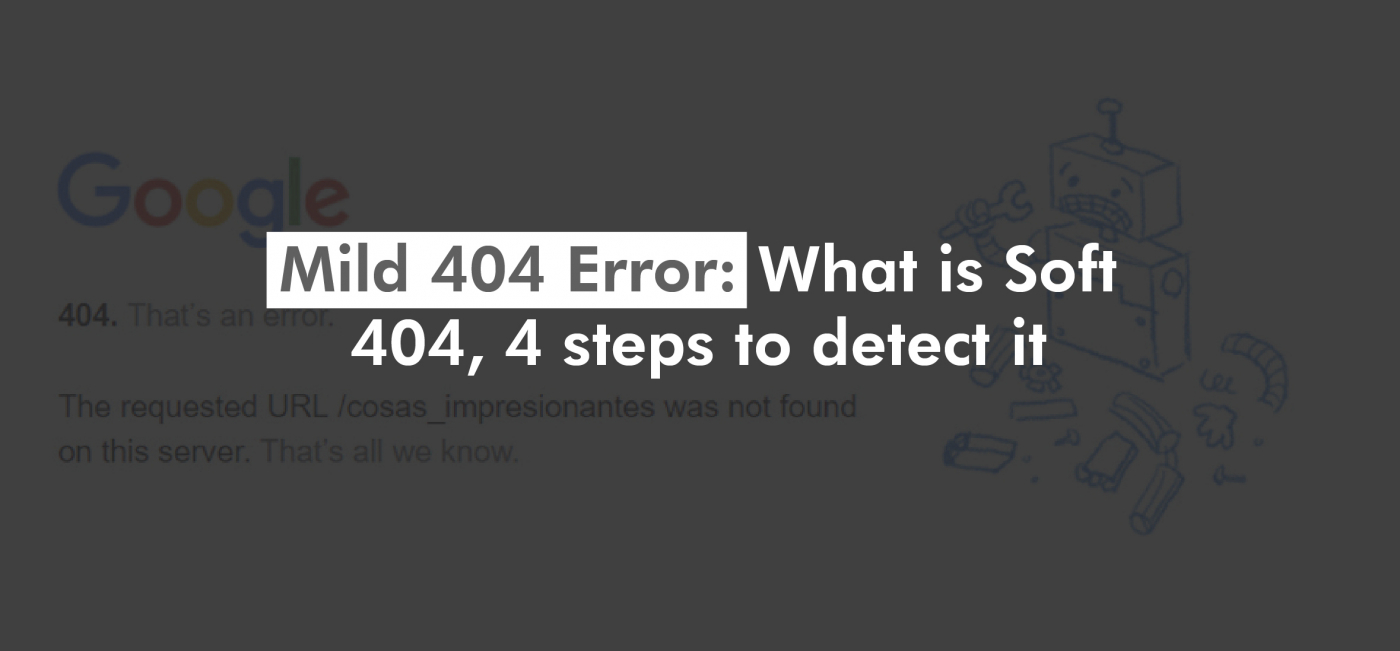When we are checking our site in Google Search Console, a reading error often tells us that there is a Soft 404 Error. But what does this Soft 404 refer to? What makes it different from the usual “404 Not Found”? What does Google tell us about it? How does it affect our site’s SEO? In this article, find out all this, with a plus: we tell you how to detect them with 4 very simple steps.
OK, This is Fine
“This is fine” says one of the most famous memes all over the net. It’s common to hear someone say this when behind what seems to be in order, lies a big fire. And this is how a Soft 404 Error works.
In a Soft 404, the URL of the site the user is trying to enter returns a 404 error code (the well-known “Not Found”), but to Google, it throws a 200 code (action received, understood, accepted, and processed). And this can be an obstacle if you want to optimize the site for SEO.
What’s wrong with a Mild 404 Error for SEO?
Let’s look at it this way: you go to buy your favorite product at your usual store. You get to the checkout and pay with your debit card. You are absolutely sure it is going to go through because, obviously, you have enough funds. Suddenly, the cashier tells you: “Excuse me, do you have another card? Your balance is insufficient”. You can see the strange look on your face from every aisle of the store. How could that happen if you still had some money left in your account?
Well, something that bad would be a Soft 404, or Soft 404 Error: a page with status code 404 (in this case, your card with insufficient funds) redirects with a 301 to Home, so it will give the browser a status code 200, of completed request (following the example, you would be the browser, which thinks that the card has sufficient funds).
This type of error is detrimental mainly for SEO, because this last code indicates to the search engines that this page exists and can be indexed to appear in the results, when in fact it no longer has content that can give it relevance and power when it comes to positioning the landing page.
404 “usual” vs. Soft 404
In most cases, both actions are carried out due to a lack of knowledge on the subject, and mainly, because we only think about one side of the problem: the user experience. Yes, of course, it is essential to give the best of our site so that, when someone enters to navigate, they stay on the page as long as possible.
The difference is in how they are resolved. By giving a Status Code 404 Not Found, we are making both users and the Google bot understand that this page no longer exists, that it no longer has the content that someone entered looking for, but with the possibility that the same user remains within the site, guiding him to related content.
When the browser shows that it is a page with this status code, the Googlebot accelerates the crawling process of the site’s landings. It skips those with a Not Found and goes straight to those with relevant content for users’ searches.
When a Mild 404 Error occurs, we are facing the possibility of losing the authority of these pages. In these pages, what actually appears is another type of landing page, generally because of a redirect to the Home page.
Some determining factors for Search Engines
There is a high chance that the browser will raise this Status Code due to the poor content of the landing page even, though it is taken as a duplicate of other pages of the site, when in fact it is not.
We already know what we are approaching with the latter: search engines can penalize our site. And from that place, it is difficult to return.
Finally, and just as serious, in this way we would be losing a potential source of the positioning of the site.
So, in case this Mild Error 404 appears, what can we do?
4 steps to avoid Mild 404 Errors
It is known that it is always better to prevent before time, that is why from Punto Rojo we give you the 4 fundamental steps so that you can take the necessary precautions and know how to discover Mild 404 errors:
- Verify from Google Search Console
The first step, the easiest one, and the reason why you probably got to this article: check the Coverage Status report of your site’s index.
Google, in its Google Search Console tool, provides you with the necessary data so that you can see what kind of errors the pages that comprise your site’s ecosystem have.
In this case, by selecting the “Error” and “Excluded” parameters, GSC will show you the number of URLs that are agglomerated under this 404 Soft, while the graph below shows each of the URLs that have it.
- Compare URLs with GSC Mild Error 404 vs. Status Code of Crawled URLs
However, we can only take this data with a preview. If we want to obtain the exact number of URLs with Mild Error 404, we must perform a crawl of them.
Different tools such as Screaming Frog or Majestic can give us a complete list of links. We must compare both results to see and verify that in these lists the URLs appear as 200 or with a 404 error. Then cross them with the data provided by Google Search Console.
It is always good to verify and make sure that no landing page is lost, especially if the site has a large number of pages. It is essential that all of them are indexed and do not throw any type of Error 404 Soft. This will make the whole site a potential source of authority if you decide to complement it with other On-Site actions.
- Have a Custom Landing 404 Not Found
It is a daily thing to enter a site and see a page that reports a 404 Error. The page may have little relevant content, warning only that the page does not exist. Or it may not have its <main> tag optimized.
For this, adding content related to the subject of the previous page to this 404 Not Found warning is a good option. What can you consider adding? Links to related pages, or even a link to the Home page; for the most creative ones, a captivating text summarizing why the landing page was unsubscribed (adding a link to a related page).
Actions can be very diverse and different from each other. The essential thing is always to keep the user within the site, and to make the search engine bots spend their time crawling that page.
- Avoiding “Default” Redirection
This is the most repeated error when canceling a landing page. For example, on an e-commerce site, a product card is out of stock.
In most cases, what is done is a redirection to the site’s Home page. This way, they do not leave the site. But we would be making a “small” mistake!
In reality, this redirect should be made to a page with a similar theme, and always make sure that its authority is permanently transmitted. This ensures that the latter happens.
In summary…
Avoid Mild 404 Errors, and prevent your site from possible penalties. The best thing to do is always to verify that the indexed pages of the site have the right status code.
That way, you are ensuring another check towards the SEO optimization of your site.
And that’s when the “This is fine” really becomes a “This is fine”.



